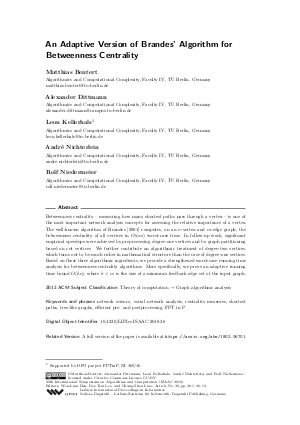An Adaptive Version of Brandes' Algorithm for Betweenness Centrality
Authors Matthias Bentert, Alexander Dittmann, Leon Kellerhals, André Nichterlein, Rolf Niedermeier
-
Part of:
Volume:
29th International Symposium on Algorithms and Computation (ISAAC 2018)
Part of: Series: Leibniz International Proceedings in Informatics (LIPIcs)
Part of: Conference: International Symposium on Algorithms and Computation (ISAAC) - License:
 Creative Commons Attribution 3.0 Unported license
Creative Commons Attribution 3.0 Unported license
- Publication Date: 2018-12-06
File

PDF
LIPIcs.ISAAC.2018.36.pdf
- Filesize: 0.55 MB
- 13 pages
Document Identifiers
Related Versions
Subject Classification
ACM Subject Classification
- Theory of computation → Graph algorithms analysis
Keywords
- network science
- social network analysis
- centrality measures
- shortest paths
- tree-like graphs
- efficient pre- and postprocessing
- FPT in P
Metrics
- Access Statistics
-
Total Accesses (updated on a weekly basis)
0Document
0Metadata
Abstract
Betweenness centrality - measuring how many shortest paths pass through a vertex - is one of the most important network analysis concepts for assessing the relative importance of a vertex. The well-known algorithm of Brandes [2001] computes, on an n-vertex and m-edge graph, the betweenness centrality of all vertices in O(nm) worst-case time. In follow-up work, significant empirical speedups were achieved by preprocessing degree-one vertices and by graph partitioning based on cut vertices. We further contribute an algorithmic treatment of degree-two vertices, which turns out to be much richer in mathematical structure than the case of degree-one vertices. Based on these three algorithmic ingredients, we provide a strengthened worst-case running time analysis for betweenness centrality algorithms. More specifically, we prove an adaptive running time bound O(kn), where k < m is the size of a minimum feedback edge set of the input graph.
Cite As Get BibTex
Matthias Bentert, Alexander Dittmann, Leon Kellerhals, André Nichterlein, and Rolf Niedermeier. An Adaptive Version of Brandes' Algorithm for Betweenness Centrality. In 29th International Symposium on Algorithms and Computation (ISAAC 2018). Leibniz International Proceedings in Informatics (LIPIcs), Volume 123, pp. 36:1-36:13, Schloss Dagstuhl – Leibniz-Zentrum für Informatik (2018)
https://doi.org/10.4230/LIPIcs.ISAAC.2018.36
BibTex
@InProceedings{bentert_et_al:LIPIcs.ISAAC.2018.36,
author = {Bentert, Matthias and Dittmann, Alexander and Kellerhals, Leon and Nichterlein, Andr\'{e} and Niedermeier, Rolf},
title = {{An Adaptive Version of Brandes' Algorithm for Betweenness Centrality}},
booktitle = {29th International Symposium on Algorithms and Computation (ISAAC 2018)},
pages = {36:1--36:13},
series = {Leibniz International Proceedings in Informatics (LIPIcs)},
ISBN = {978-3-95977-094-1},
ISSN = {1868-8969},
year = {2018},
volume = {123},
editor = {Hsu, Wen-Lian and Lee, Der-Tsai and Liao, Chung-Shou},
publisher = {Schloss Dagstuhl -- Leibniz-Zentrum f{\"u}r Informatik},
address = {Dagstuhl, Germany},
URL = {https://drops.dagstuhl.de/entities/document/10.4230/LIPIcs.ISAAC.2018.36},
URN = {urn:nbn:de:0030-drops-99846},
doi = {10.4230/LIPIcs.ISAAC.2018.36},
annote = {Keywords: network science, social network analysis, centrality measures, shortest paths, tree-like graphs, efficient pre- and postprocessing, FPT in P}
}
Author Details
Funding
- Kellerhals, Leon: Supported by DFG project FPTinP, NI 369/16.
References
-
Amir Abboud, Fabrizio Grandoni, and Virginia Vassilevska Williams. Subcubic Equivalences Between Graph Centrality Problems, APSP and Diameter. In Proc. of 26th SODA, pages 1681-1697. SIAM, 2015.

-
Miriam Baglioni, Filippo Geraci, Marco Pellegrini, and Ernesto Lastres. Fast exact computation of betweenness centrality in social networks. In Proc. of 4th ASONAM, pages 450-456. IEEE Computer Society, 2012.

-
Ulrik Brandes. A faster algorithm for betweenness centrality. J Math Sociol, 25(2):163-177, 2001.

-
Wouter De Nooy, Andrej Mrvar, and Vladimir Batagelj. Exploratory Social Network Analysis with Pajek. Cambridge University Press, 2011.

-
Vladimir Estivill-Castro and Derick Wood. A Survey of Adaptive Sorting Algorithms. ACM Comput Surv, 24(4):441-476, 1992.

-
Linton Freeman. A set of measures of centrality based on betweenness. Sociometry, 40:35-41, 1977.

-
Archontia C. Giannopoulou, George B. Mertzios, and Rolf Niedermeier. Polynomial fixed-parameter algorithms: A case study for longest path on interval graphs. Theor Comput Sci, 689:67-95, 2017.

-
David S. Johnson. The genealogy of theoretical computer science: A preliminary report. ACM SIGACT News, 16(2):36-49, 1984.

-
Mark E. J. Newman. Who Is the Best Connected Scientist? A Study of Scientific Coauthorship Networks. In Proc. of 23rd CNLS, pages 337-370. Springer, 2004.

-
André Nichterlein, Rolf Niedermeier, Johannes Uhlmann, and Mathias Weller. On tractable cases of Target Set Selection. SNAM, 3(2):233-256, 2013.

-
Kim Norlen, Gabriel Lucas, Michael Gebbie, and John Chuang. EVA: Extraction, visualization and analysis of the telecommunications and media ownership network. In Proc. of 14th ITS, 2002.

-
Rami Puzis, Yuval Elovici, Polina Zilberman, Shlomi Dolev, and Ulrik Brandes. Topology manipulations for speeding betweenness centrality computation. J Comp Net, 3(1):84-112, 2015.

-
Ahmet Erdem Sariyüce, Kamer Kaya, Erik Saule, and Ümit V. Çatalyürek. Graph Manipulations for Fast Centrality Computation. ACM Trans Knowl Discov Data, 11(3):26:1-26:25, 2017.

-
Flavio Vella, Massimo Bernaschi, and Giancarlo Carbone. Dynamic Merging of Frontiers for Accelerating the Evaluation of Betweenness Centrality. ACM JEA, 23(1):1.4:1-1.4:19, 2018.

-
Wei Wang and Choon Yik Tang. Distributed computation of node and edge betweenness on tree graphs. In Proc. of 52nd CDC, pages 43-48. IEEE, 2013.

